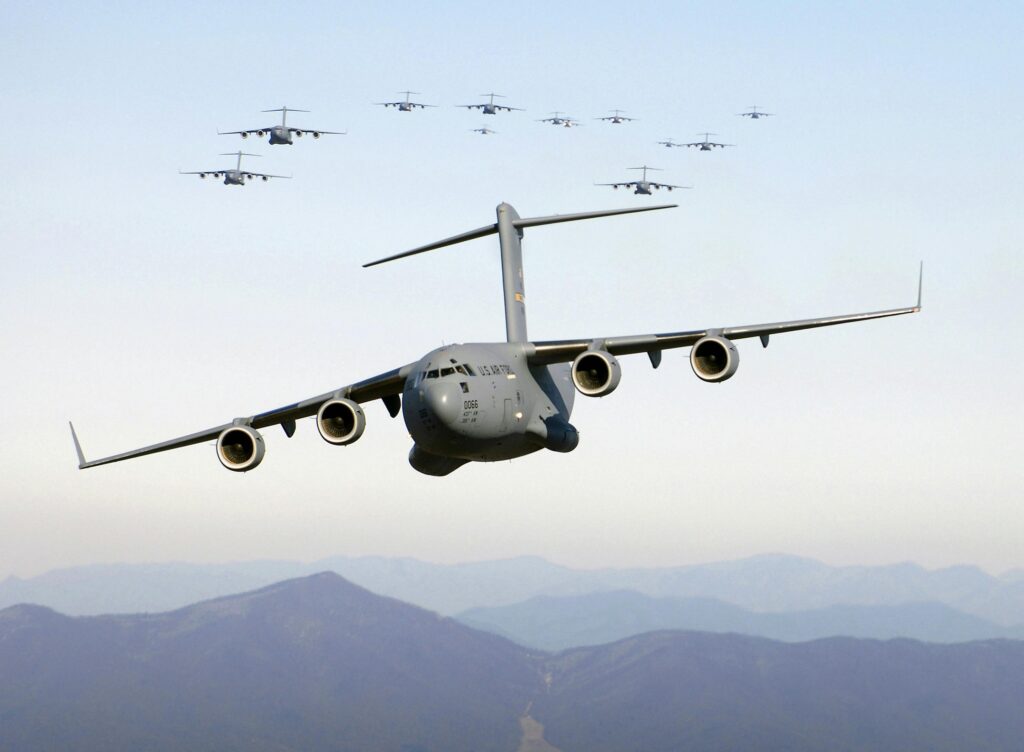Unmanned aerial vehicles, or UAVs, have changed a lot over time. They started for the military but now help in farming, watching over places, and even delivering things. Learning about UAVs shows how fast they’ve grown and how they fit into today’s world.
This article looks at the history of UAVs. We’ll see how they’ve changed, the new tech they use, and how they’re used in many areas. This includes the exciting world of drones.
The History of Unmanned Aerial Vehicles (UAVs)
A collage showcasing the evolution of unmanned aerial vehicles through different historical eras, featuring early biplane-style drones, World War II military UAVs, modern sleek commercial drones, and futuristic concepts, all depicted flying over diverse landscapes such as battlefields, urban cities, and serene countryside. The scene is vibrant and dynamic, illustrating the progression in design and technology throughout the decades.
Key Takeaways
- UAVs began mainly for the military.
- Now, they help in farming and watching over places too.
- Their history shows big tech improvements over time.
- They’re now used for delivering things too.
- The drone world keeps growing and changing.
Introduction to Unmanned Aerial Vehicles
Unmanned Aerial Vehicles, or drones, are a big step forward in flying technology. They can fly on their own or be controlled from far away. These drones are used in many ways, thanks to their unmanned aerial vehicle technology.
Drones can do things that are hard or dangerous for people to do. They can take pictures from high up or help in the military. They have special tools like cameras and sensors to help them do their job well.
More and more places are using drones. They help with watching over areas, checking on farms, and moving things around. This shows how important it is to keep making drones better and to make rules for them.
| Application | Description | Benefits |
|---|---|---|
| Aerial Photography | Capturing images and videos from stunning aerial perspectives | High-quality visuals for real estate, advertising, and events |
| Agricultural Monitoring | Analyzing crop health and land use | Efficient resource management and yield optimization |
| Search and Rescue | Assisting in locating missing persons and assessing disaster areas | Rapid response and improved safety for rescue teams |
| Delivery Services | Transporting goods and medications to remote locations | Reduced delivery times and access to underserved areas |
The History of Unmanned Aerial Vehicles (UAVs)
UAVs have changed military ways a lot. They started with simple drones and grew into complex systems. This shows how military needs and UAV tech have changed over time.
Early Developments in UAV Technology
UAVs began in World War I. They were used for practice and training. The first drones were simple but showed UAVs’ future in the military.
The Kettering Bug was an early example. It showed UAVs’ early promise. It was a start to what UAVs could do in war.
Military Innovations and Their Impact
The Vietnam War made UAVs more important. New UAVs changed how wars were fought. The RQ-1 Predator in the 1990s was a big step forward.
This drone could gather detailed information. It helped in making better war plans. It showed how drones changed war.
UAVs now help gather information fast. This helps leaders make quick decisions. It also keeps soldiers safer. UAVs have come a long way, leading to new ideas in
Types of Unmanned Aerial Vehicles
Unmanned Aerial Vehicles (UAVs) are made in many types. Each type is made for certain jobs. We will look at three main types: fixed-wing, rotary-wing, and hybrid UAVs.
Fixed-Wing UAVs
Fixed-wing UAVs look like airplanes. They can fly for a long time and go fast. They are great for jobs like watching and checking things out.
They are used for things like watching crops, making maps, and checking the environment. The Global Hawk and ScanEagle are examples. They can fly for a long time and go far.
Rotary-Wing UAVs
Rotary-wing UAVs, or helicopter drones, use spinning blades to fly. They can move around easily and land and take off like a helicopter. This makes them good for jobs like finding people, checking buildings, and taking pictures from the air.
The DJI Phantom series is a good example. It shows how these drones are used in work and are easy to use.
Hybrid UAVs
Hybrid UAVs mix the best of fixed-wing and rotary-wing drones. They can take off and land like a helicopter and fly fast like an airplane. This makes them good for many jobs, like mapping cities, checking buildings, and helping in emergencies.
The Bell Nexus is an example. It shows how new drone technology is being made.
A dynamic collage showcasing various types of unmanned aerial vehicles (UAVs), including a sleek military drone, a nimble racing drone, an agricultural surveillance drone hovering over fields, a large cargo drone in mid-flight, and a compact consumer drone, all set against a vibrant sky with clouds, emphasizing the diversity and technology of modern aerial innovations.
| Type of UAV | Characteristics | Common Applications |
|---|---|---|
| Fixed-Wing UAVs | Long flight durations, high speeds | Agricultural monitoring, mapping, surveillance |
| Rotary-Wing UAVs | Maneuverable, capable of hovering | Search and rescue, inspections, photography |
| Hybrid UAVs | Combines capabilities of fixed and rotary | Urban mapping, infrastructure inspection, emergency response |
Key Milestones in UAV Development
The world of unmanned aerial vehicles has seen big changes. These changes have made UAVs better than ever. Looking back at historical drones helps us see how far we’ve come.
Pioneering UAV Models
The Aerial Target was one of the first drones, used in World War I. It was for training. Then, the RQ-2 Pioneer helped with military missions. The MQ-1 Predator took it to the next level, improving how we watch and fight.
These drones were the start of what we have today. They showed us what’s possible.
Technological Advancements Over the Decades
UAVs have changed a lot over time. Big steps include:
- GPS for better navigation
- Better batteries for longer flights
- New materials and sensors for better performance
These changes show how UAV innovation keeps growing. They help drones work better for both the military and regular people. These updates mean drones are now more useful and reliable.
The Role of UAVs in Modern Industries
Unmanned Aerial Vehicles (UAVs) are changing many fields. They bring new ways to work in aerospace, agriculture, and more. This makes things better for everyone.
Aerospace and Defense
Military drones are key in the aerospace and defense world. They help with watching, finding out, and hitting targets. Defense applications use UAVs to get important info and make missions better. The U.S. Air Force uses many drones to work more efficiently.
Agriculture and Environmental Monitoring
Agricultural drones help farmers see how crops are doing right away. They help use less pesticide and grow more food. Drones with special cameras help farmers make smart choices, saving money. They also help watch wildlife and stop forests from being cut down.
Commercial Applications and Delivery Services
UAVs are being used more in business, like for taking pictures from the air. Companies like Amazon and UPS want to use delivery drones to make getting things faster. This could change how we get our stuff, making things easier and faster.
| Industry | Applications | Benefits |
|---|---|---|
| Aerospace and Defense | Surveillance, reconnaissance, precision strikes | Reduced risk to personnel, real-time intelligence |
| Agriculture | Crop monitoring, pesticide application | Increased yields, cost savings |
| Commercial | Aerial photography, delivery services | Efficiency in logistics, new retail opportunities |
Challenges and Future Trends in UAV Technology
UAV technology has changed many industries a lot. But, it also brings big challenges. We need to find a good balance between new ideas and rules. This is key to using UAVs to their fullest.
Big issues include UAV rules, drone laws, and problems with using UAVs. These can slow down how fast we can use these new techs.
Regulatory Hurdles
As UAVs fly more, we face new rules. The Federal Aviation Administration (FAA) must make rules for safety and privacy. These rules cover:
- Flight safety measures
- Airspace management protocols
- Privacy laws concerning surveillance capabilities
- Remote identification for accountability of drone operators
These UAV rules must grow with new drone tech. Clear drone laws help users follow rules and try new things.
Emerging Technologies and Innovations
The future of UAVs depends on new tech. New drones use artificial intelligence (AI). This means:
- Drone decisions get smarter in real time
- Drone paths get better with AI
- Drone talk gets better with 5G
These new things help solve old UAV problems. By using these new techs, drones can do better in many areas. This looks good for the future of drones.
| Category | Challenge | Emerging Solutions |
|---|---|---|
| Regulatory Framework | Complex drone laws | Streamlined legislation |
| Safety | Flight stability concerns | AI-assisted navigation |
| Privacy | Surveillance issues | Remote identification systems |
| Communication | Data transfer limitations | 5G integration |
These new things will help fix problems and make UAVs better for many industries.
Conclusion
Unmanned aerial vehicles (UAVs) have come a long way. They started as simple ideas and grew into complex, useful machines. This journey shows how UAVs have changed and become important in many fields.
Looking ahead, UAVs will keep getting better. They will face new rules and use new tech like AI and better sensors. This will open up new ways for UAVs to help us.
Investing in UAV research will help them meet our changing needs. They will become more part of our daily lives. UAVs will be key in our tech-filled world.


